The official currency of Guatemala is the Guatemalan quetzal (GTQ), named after the national bird of Guatemala, the resplendent quetzal. The quetzal has been the official currency of Guatemala since 1925.
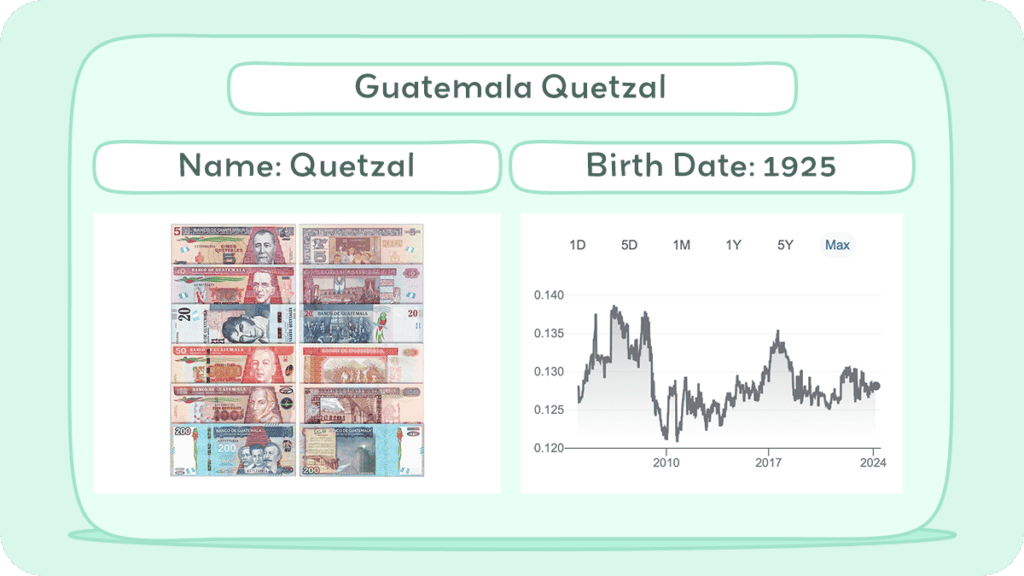
This article explores the Guatemalan quetzal, Guatemala’s official currency, covering its history from ancient times to the present. It looks at the quetzal’s role in Guatemala’s economy, its stability, and its importance in commerce.
Historical Journey of Guatemalan Quetzal
Guatemala’s currency dates back to the time of the Mayan civilization. Over the years, the currency of Guatemala has undergone several changes, reforms, and transformations; from the peso to the quetzal, and the adoption of the U.S. dollar as a second official currency.
The first currency used in Guatemala was the “peso,” which was created by the government of Rafael Carrera when the national state emerged and founded the Republic of Guatemala. The peso was a silver and gold coin system that replaced the real. In 1859, the peso was replaced by the Guatemalan peso, which was in circulation until 1925.
Quetzal bills come in denominations of 1, 5, 10, 20, 50, 100, and 200, while coins come in denominations of 1, 5, 10, 25, and 50 centavos. In 1925, the Guatemalan quetzal was introduced during the term of President José María Orellana.
The quetzal was named after the national bird of Guatemala, the resplendent quetzal. Until 1987, the quetzal was pegged to and domestically equal to the United States dollar.
History of Coins
The Guatemalan quetzal was introduced in 1925 by President José María Orellana, whose image is on the one-quetzal bill. It replaced the Guatemalan peso at a rate of 60 pesos to 1 quetzal and was equal to the U.S. dollar until 1987. The initial coin denominations were 1, 5, 10 centavos, and 1⁄4, 1⁄2, and 1 quetzal.
Most 1 quetzal coins were later withdrawn and melted. In 1932, 1⁄2 and 2 centavo coins were added. Coins minted until 1965 with values of 5 centavos or more were 72% silver. 1⁄2 and 1 quetzal coins were reintroduced in 1998 and 1999.
Currently, Guatemalan coins feature the national coat of arms on the front. The reverse sides depict various cultural and national symbols:
- 1 centavo shows Friar Bartolomé de las Casas
- 5 centavos have the tree of liberty
- 10 centavos display a monolith from Quiriguá
- 25 centavos feature indigenous woman Concepción Ramírez
- 50 centavos portray the Monja Blanca national flower
- 1 quetzal coins depict a stylized dove, the word “Paz (Peace),” and the date “29 de Diciembre de 1996.”
History of Bills
The Central Bank of Guatemala initially issued banknotes in 1, 2, 5, 10, 20, and 100 quetzales denominations, adding 1⁄2 quetzal notes in 1933.
In 1946, the Bank of Guatemala took over paper money issuance, first by overprinting Central Bank notes. The denominations remained largely the same except for introducing 50 quetzal notes in 1967.
In the late 1990s, 1⁄2 and 1 quetzal coins replaced the corresponding notes. Additionally, each banknote features the value in Mayan numerals on the top-right corner of the front side, reflecting Guatemala’s cultural heritage.
Inflation and Buying Power of Guatemala Currency
The value of a currency is a critical factor in determining the economic well-being of a country. Inflation refers to the rate at which the general level of prices for goods and services is rising.
The inflation rate in Guatemala has been relatively stable over the past few years. According to the IMF Country Report No. 23/172 GUATEMALA, inflationary pressures remain high, with April 2023 headline inflation at 8.32 percent.
During the observation period from 1960 to 2022, the average inflation rate was 7.8% per year. The inflation rate for consumer prices in Guatemala moved over the past 62 years between -1.2% and 41.2%. For 2022, an inflation rate of 6.9% was calculated. Overall, the price increase was 9,154.09% as per Worlddata.info.
Inflation has a significant impact on the buying power of a currency. As inflation increases, the cost of goods and services goes up, and the value of money goes down. Therefore, the purchasing power of a given currency decreases. High inflation rates can lead to a decrease in consumer confidence, economic instability, and a decrease in foreign investment.
The purchasing power parity (PPP) of Guatemala increased from 2.7 LCU per international dollars in 2003 to 3.9 LCU per international dollars in 2022, growing at an average annual rate of 2.02% according to knoema.com.
Guatemalan Quetzal
Q0.50
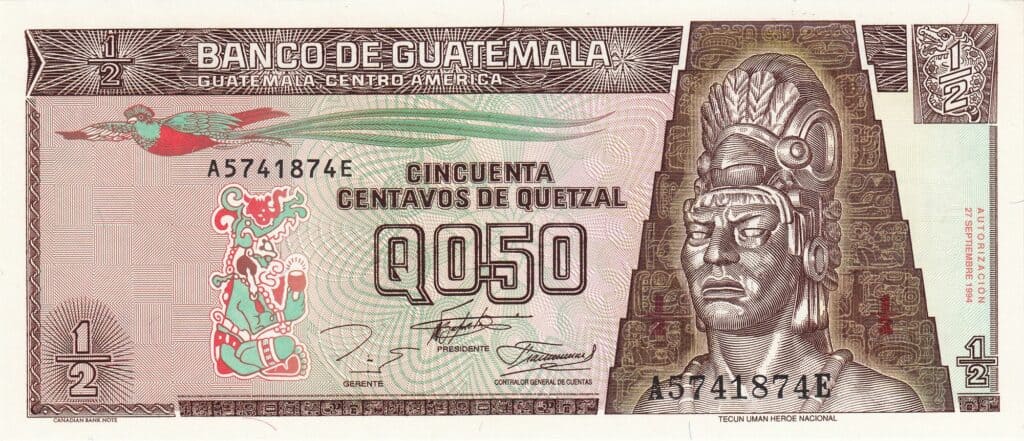
The 0.50 quetzal banknote of Guatemala features Tecun Uman on the front and the Tikal temple on the back.
Q1
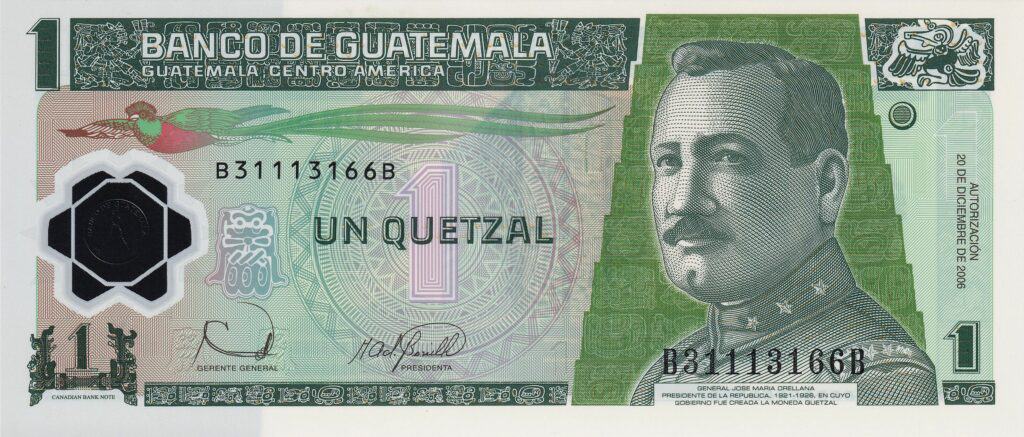
The 1 quetzal banknote from Guatemala has President Jose Maria Orellana on the front and the main building of the Central Bank of Guatemala on the back.
Q5
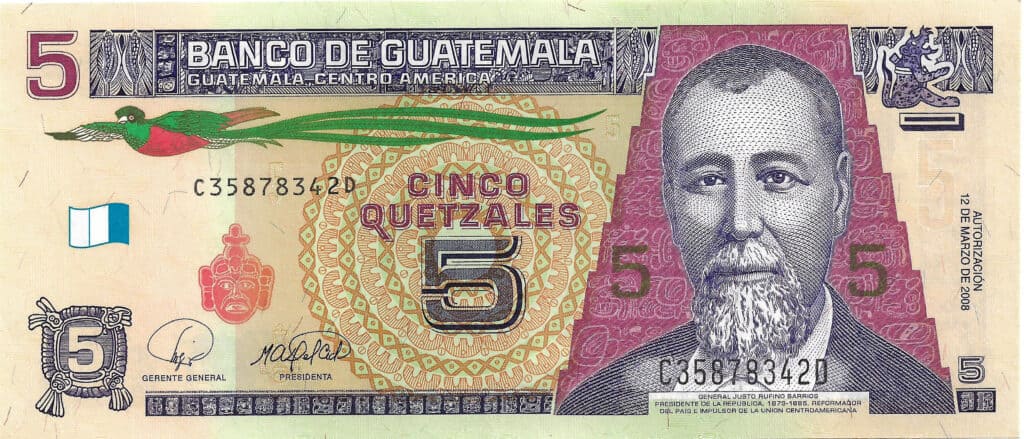
The 5 quetzal banknote from Guatemala features a portrait of General Justo Rufino Barrios on the front and an illustration of a classroom on the back.
Q10
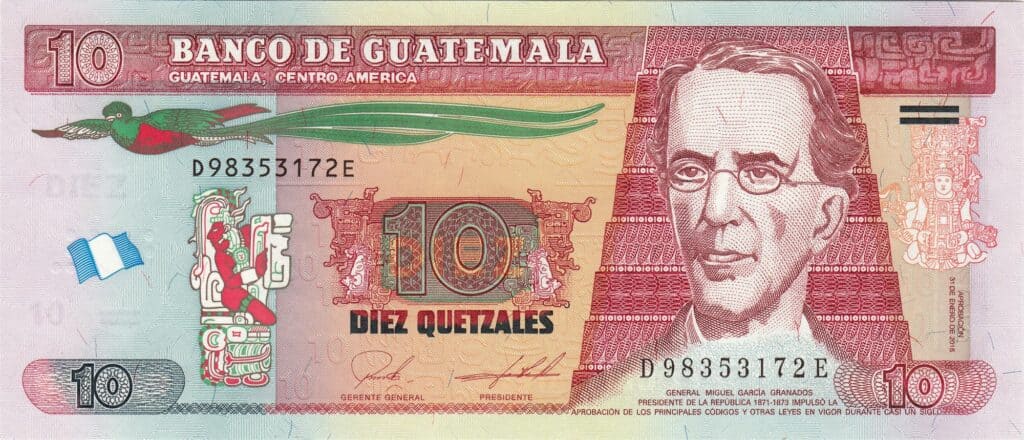
The 10 quetzales banknote from Guatemala has red print with multicolor underprint and black serial numbers. It features General Miguel Garcia Granados on the front and an image of the 1892 session of the National Legislative Assembly on the back.
Q20
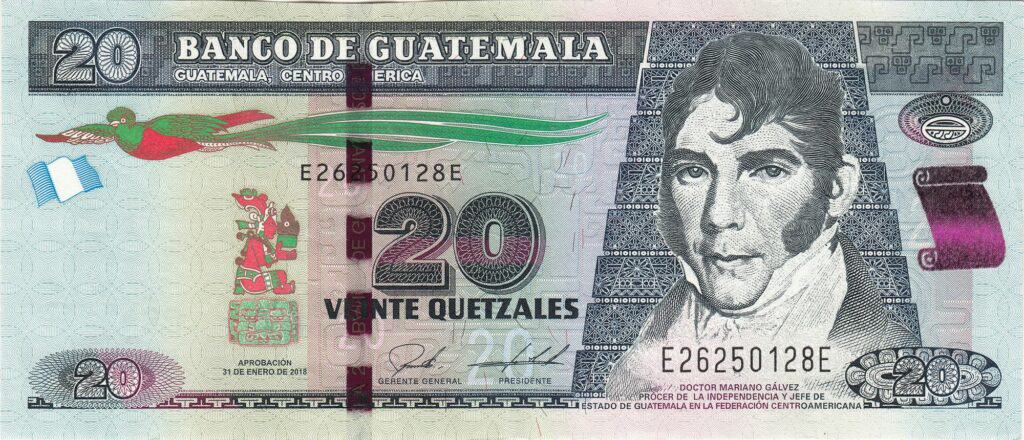
The 20 quetzales banknote from Guatemala features Mariano Gálvez, a former leader of the State of Guatemala within the United Provinces of Central America, on the front. On the back, it depicts the signing of the declaration of Central American independence.
Q50
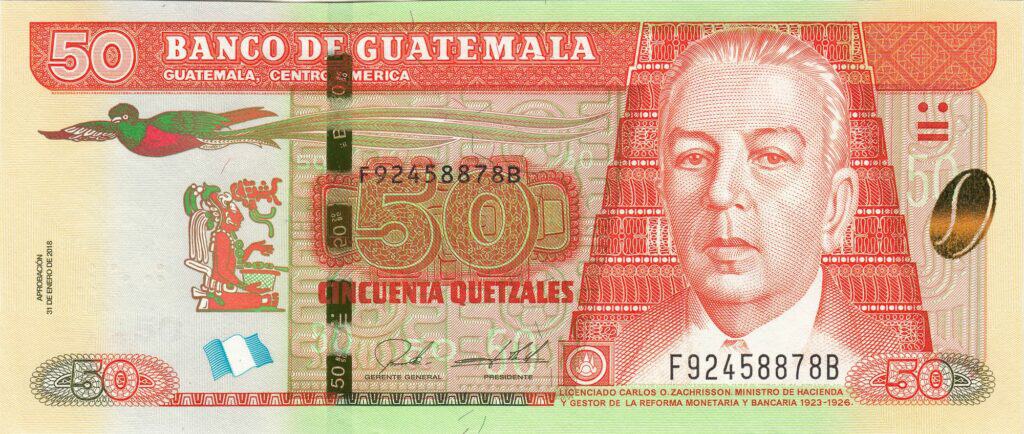
The 50 quetzales banknote from Guatemala, in orange color, features Carlos Zachrisson, former finance minister from 1923 to 1926, on the front. The back of the note displays an allegory representing the importance of coffee to the country.
Q100
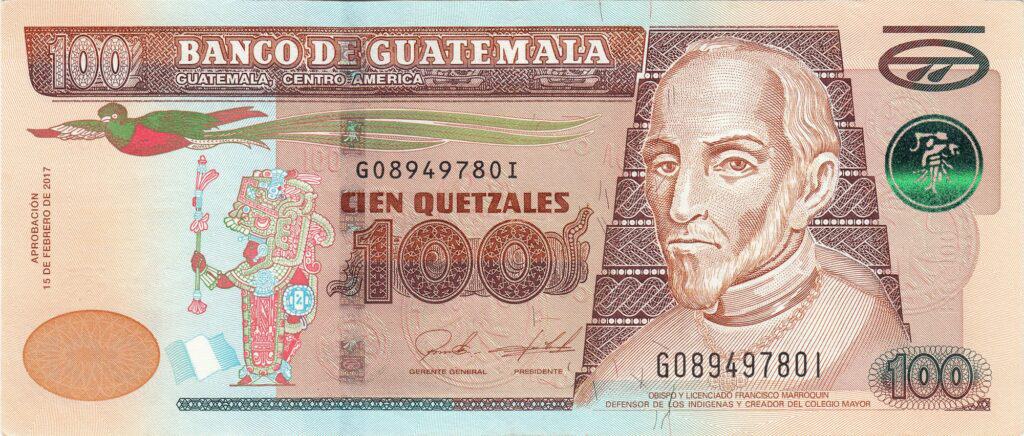
The 100 quetzales banknote from Guatemala, in sepia color, has Francisco Marroquín, the first Bishop of the Realm of Guatemala and founder of the Universidad de San Carlos de Guatemala, on the front. The back features the first university building in Antigua Guatemala.
Q200
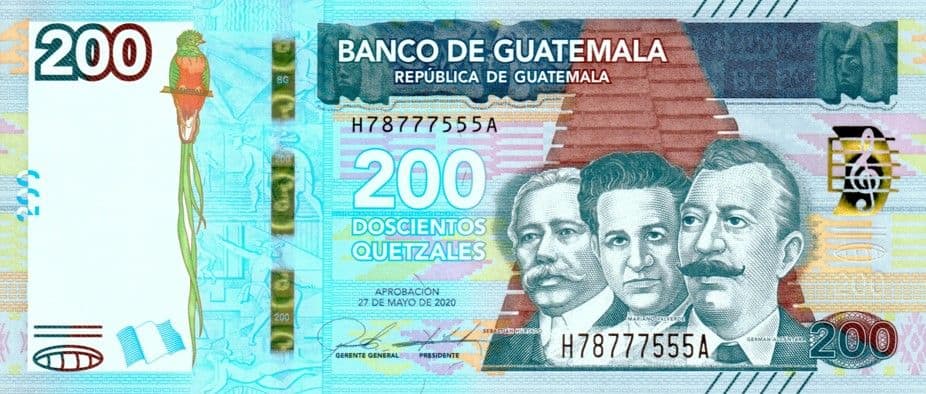
The 200 quetzales banknote from Guatemala, in aqua color, features Sebastian Hurtado, Mariano Valverde, and German Alcántara, three marimba composers, on the front. The back of the note displays an allegory of the marimba, Guatemala’s national instrument, along with the musical score of “La Flor del Café” by Alcántara.
Currency Usage in Guatemala
The official currency in Guatemala is the quetzal (GTQ), named after the national bird of Guatemala. The quetzal is divided into 100 centavos, and there are both paper bills and coins in circulation.
The quetzal (GTQ) is used for most transactions, from city shopping to rural markets, while US dollars are sometimes accepted in tourist areas.
Guatemala is largely a cash-based society; ATMs are common, but credit cards may not be widely accepted, especially in smaller towns.
Quetzal bills are available in denominations of 1, 5, 10, 20, 50, 100 and 200. Digital payments are slowly growing, particularly in urban areas, with apps like Tigo Money and Venmo gaining popularity.
Is USD accepted in Guatemala?
In 1991, the exchange rate system was liberalized, allowing the quetzal to float freely against other currencies.
In 2001, Guatemala adopted the U.S. dollar as a second official currency, which is widely used in tourist areas and for international transactions.
While the US dollar is accepted in Guatemala, it is a good idea to have smaller quetzal bills on hand. You can exchange your foreign currency at banks, exchange offices, and hotels. However, it is important to compare the exchange rates before exchanging money to get the best deal.
Exchanging Currency in Guatemala
When exchanging currency for a trip to Guatemala, consider various options and watch out for pitfalls. Banks are safe with competitive rates but have limited hours and may require ID.
ATMs are widely available but come with fees. Be cautious of hidden fees, counterfeit quetzales, and the inconveniences of traveler’s checks. To be wise with your money, bring some quetzales in advance, exchange larger amounts for better rates, consider using a pre-loaded travel card, and inform your bank of your travel plans.
Tools like Xe.com and Wise can help you compare rates and manage your money efficiently. By being informed and cautious, you can enjoy a hassle-free financial experience in Guatemala.
Where can I exchange Guatemala currency?
You can easily exchange USD for GTQ at banks and exchange bureaus throughout Guatemala, but it’s important to note that many businesses in Guatemala only accept cash.
In Guatemala, you have several accessible bank options for exchanging currency to quetzales, ensuring a smooth transaction during your trip.
Banco Agrícola, with over 200 branches, is easily accessible, including in rural areas. G&T Continental is known for its commitment to accessibility. Banco de los Trabajadores has a strong presence in smaller towns and villages, with accessibility features.
Remember to carry identification, like a passport, for currency exchange and inform your bank of your travel plans to avoid issues with card usage.
What to know before exchanging currency in Guatemala
Guatemala is predominantly a cash-based society, so carrying enough quetzales, especially in smaller towns, is important. Formal businesses typically prefer quetzales, while informal vendors may accept a mix of quetzales and US dollars.
Familiarize yourself with the various denominations of quetzal bills and coins. For currency exchange, banks are the safest but have limited hours and may require ID. Currency exchange bureaus offer faster service but compare rates first.
Hotels and ATMs are options, but watch for less favorable rates and fees. Be cautious of hidden fees, counterfeit bills, and the inconvenience of traveler’s checks.
It’s wise to bring some quetzales in advance, exchange larger amounts for better rates, consider using a pre-loaded travel card, and inform your bank of your travels.
Choosing Between USD and Guatemalan Quetzal
When deciding whether to use USD or Guatemalan quetzales (GTQ) in Guatemala, consider factors like exchange rates, convenience, associated fees, and other tips. This will help you make a well-informed choice for your transactions.
Exchange Rate
When it comes to exchange rates in Guatemala, it’s important to note that using the Guatemalan quetzal (GTQ) is generally more favorable than using US dollars (USD) directly for your purchases.
If you exchange your currency for GTQ in advance or use ATMs to withdraw GTQ while in Guatemala, you can typically get better rates compared to using USD. So, it’s advisable to opt for GTQ to ensure more favorable exchange rates during your travels in Guatemala.
Convenience
When considering convenience in Guatemala, it’s important to know that US dollars (USD) are widely accepted in tourist areas and major cities, making them familiar and convenient for travelers.
However, in smaller towns and villages, using USD might be less convenient. On the other hand, the Guatemalan quetzal (GTQ) is the preferred currency throughout the country, ensuring hassle-free transactions wherever you go.
However, it’s essential to either pre-exchange your currency for GTQ or rely on ATMs, which may be less readily available in remote areas. So, while USD offers convenience in some places, GTQ is generally more convenient for a smooth experience across Guatemala.
Fees
When it comes to fees in Guatemala, there are considerations for both USD and Guatemalan quetzales (GTQ). When using USD, some vendors may charge a markup, resulting in hidden fees.
Moreover, you’re likely to incur ATM fees when withdrawing USD. On the other hand, when dealing with GTQ, exchange bureaus and banks might charge fees, but comparing rates can help minimize these costs.
Additionally, ATM fees for GTQ withdrawals are applicable, though they may be lower compared to withdrawing USD. So, being aware of these potential fees and comparing rates is essential for cost-effective transactions in Guatemala.
Tips
When managing your currency in Guatemala, consider a combination of both USD and Guatemalan quetzales (GTQ) for a smooth experience.
Bring some USD for initial convenience, and exchange additional funds for GTQ as needed. It’s important to compare exchange rates online using resources like Xe.com or Wise to get the best deals.
Also, inform your bank about your travel plans to avoid card alerts when using them abroad. Embracing the local experience by using GTQ connects you to the local economy and shows cultural sensitivity.
However, remember to watch out for hidden fees that some vendors may charge for USD acceptance, and be aware that ATM fees apply to both USD and GTQ withdrawals, so it’s wise to compare costs.
These tips will help you navigate the currency landscape in Guatemala effectively.
Cost of Living in Guatemala
If you are planning to move to Guatemala or visit the country, it is essential to know the cost of living. Guatemala is one of the most affordable countries in Central America, with a low cost of living compared to the United States and Europe.
The cost of living in Guatemala depends on various factors, including your lifestyle, location, and budget. The two main cities in Guatemala—Guatemala City and Antigua—have a higher cost of living than other smaller cities and towns. However, even in these cities, the cost of living is still significantly lower than in the United States or Europe.
Housing is one of the most significant expenses in Guatemala. The cost of rent varies depending on the location, size, and quality of the property.
In Guatemala City, the average cost of a one-bedroom apartment in the city center is around 3,882.85 Q (~$497 USD) per month, while a three-bedroom apartment can cost 8,017.63 Q (~$1028 USD) per month. In smaller cities and towns, the cost of rent is generally lower.
Food is relatively cheap in Guatemala, especially if you stick to the local cuisine. A meal at a local restaurant can cost as little as 35 Q (~$4.50 USD), while a meal at a higher-end restaurant can cost up to 300 Q (~$38 USD).
Transportation in Guatemala is relatively inexpensive, with a one-way ticket on public transportation costing around 5 Q (~$0.64). Taxis are also affordable costing around 30 Q (~$3.85).
Overall, the cost of living in Guatemala is significantly lower than in the United States or Europe, making it an attractive destination for budget-conscious travelers and expats.
Don’t Get Scammed Tips
To have a safe and enjoyable adventure in Guatemala, it’s essential to stay vigilant and aware of potential scams. Here are some tips to keep in mind:
- In transportation, choose licensed taxis with clear identification and negotiate fares upfront. Stick to main bus stations and reputable bus companies, avoiding overcrowded or suspiciously cheap buses. Pre-arrange private shuttles with reputable companies and avoid soliciting rides from strangers.
- Book accommodation through trusted platforms or reputable hotels and be cautious of deals that seem too good to be true. Store valuables in hotel safes and keep copies of important documents. Beware of fake hotel staff offering “upgrades” or claiming your room is unavailable.
- Exchange currency at official banks or bureaus, avoiding street vendors with poor rates. Use ATMs in well-lit, secure locations and avoid withdrawing large sums at once. Use major credit cards cautiously, especially in crowded areas, and inform your bank about your travel plans.
- Hire licensed guides from authorized agencies and avoid people offering unofficial tours. Be cautious of hidden fees for activities or attractions and ask for clear pricing upfront. Purchase souvenirs from reputable vendors and be wary of overpriced or counterfeit items.
- Learn basic Spanish phrases to avoid misunderstandings and scams. Dress modestly and avoid flashy clothing and jewelry. Trust your instincts. if something feels off, it probably is. Don’t hesitate to walk away from suspicious situations.
By following these tips and staying vigilant, you can ensure a safe and enriching experience in Guatemala.

